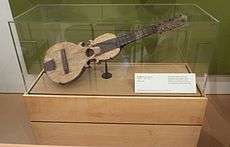Décima
A décima is a ten-line stanza of poetry, and the song form generally consists of forty-four lines (an introductory four-line stanza followed by four ten-line stanzas). It is also called "espinela" after its founder, Vicente Espinel (1550–1624), a Spanish writer and musician of the Siglo de Oro.
The décima deals with a wide range of subject matter, including themes that are philosophical, religious, lyrical, and political. Humorous décimas typically would satirize an individual's weakness or foolish act. A decimero would frequently challenge the target of the satire or his/her defender to respond in kind with a décima, thereby setting up a song duel that tested the originality and wit of contending composers.[1]
Latin America and Spain
| Music of Puerto Rico | |
|---|---|
 A (c. 1900 - 1915) Puerto Rican Cuatro | |
| General topics | |
| Related articles | |
| Genres | |
| Nationalistic and patriotic songs | |
| National anthem | La Borinqueña |
| Regional music | |
| |
The decima in all Latin America and in Spain is a style of poetry that is octosyllabic and has 10 lines to the stanza. The rhyming scheme is ABBAACCDDC. It is spoken, sung and written throughout Latin America with variations in different countries. It is often improvised.[2]
Each country has its own melody and tone ("tonada") and a different instrument, but the style and structure is exactly the same. A person who writes or improvises décima is known as a decimista or decimero.
The term "octosyllabic" may be misleading to English speakers; the Spanish term refers to a line whose final accented syllable is its seventh. An octosyllabic line may therefore have only seven syllables or, less commonly, nine.
Poetry
"Juyzio hallado y trobado"
"La vida es sueño"
Pedro Calderón de la Barca wrote in décimas some stanzas of Life is a Dream.
Nicomedes Santa Cruz made poems about Peruvian life and culture in décimas.
Songs
Many songs are in the form of décima. For example, Violeta Parra's Volver a los Diecisiete and 21 son los Dolores.
Folk singing manifestation
| External audio | |
|---|---|
A payada is a sung duel of improvised décimas.
Ecuador
The Ecuadorian décima is an oral poetic form that exists among the black population of the Esmeraldas Province. A décima consists Lof 44 lines, each of which generally has eight syllables. A décima consists of one stanza of four lines, and four more stanzas of ten Olines each. Each of the four lines of the first stanza is repeated later in the poem. Sometimes when these lines are repeated, they are Vslightly altered. Patterns of rhyme and meter are not governed by any particular rules.[3]
During declamation, there is a pause between stanzas, as well as a pause between the fourth and fifth lines of each ten-line stanza. PThis is reflected in the structure of the poems as well: a transcription of a décima will invariably have a period or a semicolon at the Eend of the fourth line. Some older decimeros add an additional pause between the eighth and ninth line of each ten-line stanza.[3]
The structure of the décima suggests that it is derived from the Spanish glosa, which also employs eight-syllable lines and a break between the fourth and fifth lines of a ten-line Istanza.[3]
Décimas are generally anonymous. Though many decimeros claim to have composed the décimas they recite, this is rarely the case. One scholar of décimas said he met only one decimero who actually composed his own décimas, and that decimeros living in different areas often claimed to have composed the same poems.[3]
References
- Chicano Popular Culture, Que Hable el Pueblo, written by Charles M. Tatum.
- "Como se compone una décima puertorriqueña". The Puerto Rican Cuatro Project (in Spanish). Retrieved 15 February 2019.
- Rahier, Jean Muteba. "Creolization and African Diaspora Cultures: The Case of the Afro-Esmeraldian Decimas". In The Ecuador Reader (Carlos de la Torre & Steve Striffler, eds.), pp. 226-236. Duke University Press (2008). ISBN 978-0-8223-4374-5.
Sources
- Clark, Dorothy Clotelle. "espinela." The New Princeton Encyclopedia of Poetry and Poetics. Princeton, New Jersey: Princeton University Press,1993.
Cuddon, J. A. A Dictionary of Literary Terms New York: Penguin, 1979. - Coplas y décimas de la tradición lojana, 1990. [Quito] : Centro de Difusión Cultural, Asociación Lojana, [1991?]. OCLC 27225375.
- Juan García. La poesía negrista en el Ecuador. Esmeraldas, Ecuador: Banco Central del Ecuador, 1982. OCLC 10486497.
- Juan García. Cuentos y decimas afro-esmeraldeñas. Quito, Ecuador : Ediciones Abya-Yala, 1992. OCLC 37807262.
- Juan García Salazar. Los guardianes de la tradición: compositores y decimeros : décimas y argumentos de tradición oral en las comunidades afroecuatorianas de Esmeraldas. Esmeraldas, Ecuador: PRODEPINE, Proyecto de Desarrollo de los Pueblos Indigenas y Negros, 2002. OCLC 230742437.
- Laura Hidalgo Alzamora. Décimas esmeraldeñas. Quito: Libresa, 1995. ISBN 978-9978-80-338-7.
- Ana María Kleymeyer. La décima: fusión y desarrollo cultural en el Afropacífico. Quito, Ecuador: Ediciones Abya-Yala, 2000. ISBN 978-9978-04-609-8.
- Jean Rahier. La décima : poesía oral negra del Ecuador. Quito: Ediciones Abya Yala: Centro Cultural Afro-Ecuatoriana, [1987?]. OCLC 18244100.
Further reading
- Canto a la Décima Puertorriqueña Audio CD by Edwin Colón Zayaz, Instituto de Cultura Puertorriqueña, 2005